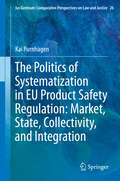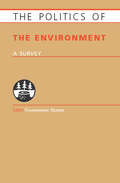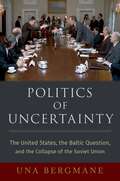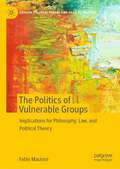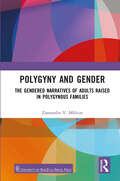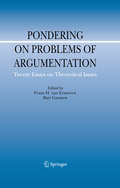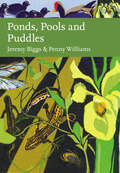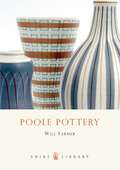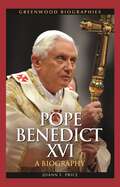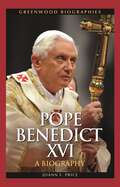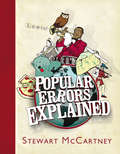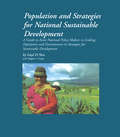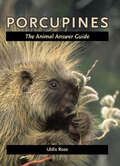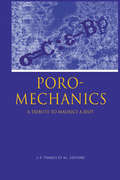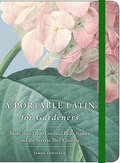- Table View
- List View
The Politics of Systematization in EU Product Safety Regulation: Market, State, Collectivity, and Integration (Ius Gentium: Comparative Perspectives on Law and Justice #26)
by Kai PurnhagenThis book examines the increasing role of the legal method of systematisation in European Union (EU) law. It argues that the legal method of systematisation that has been developed in a welfare-state context is increasingly used as a regulative tool to functionally integrate the market. The book uses the example of EU product regulation as a reference to illustrate the impact of systematisation on EU law. It draws conclusions from this phenomenon and redefines the current place and origin of systematisation in the EU legal system. It puts forward and demonstrates two main arguments. First, in certain sectors such as in EU product safety law, the quality of EU law changes from a sector-specific and reactive field of law to an increasingly coherent legal system at European level. Therefore, instead of punctual market intervention, it increasingly governs whole market areas. By doing so, it challenges and often fully replaces the respective welfare-based legal systems in the Member States for the benefit of the ideal of a market-driven EU legal system. Second, at European level, the ideal is in development. This illustrates the change of the function of Statecraft from nation-states to market-states.
Politics of the Environment: A Survey
by Chukwumerije OkerekeThe environment is increasingly seen at the forefront of many political agendas. Covering important topics, such as the Kyoto protocol and deforestation, this book provides extensive coverage of all aspects of environmental politics. Essays of around 6,000 words in length make up the bulk of the book. Written by notable experts in the field of environmental politics, these essays each examine a different aspect of the subject.
Politics of the Environment: A Survey
by Chukwumerije OkerekeThe environment is increasingly seen at the forefront of many political agendas. Covering important topics, such as the Kyoto protocol and deforestation, this book provides extensive coverage of all aspects of environmental politics. Essays of around 6,000 words in length make up the bulk of the book. Written by notable experts in the field of environmental politics, these essays each examine a different aspect of the subject.
Politics of Uncertainty: The United States, the Baltic Question, and the Collapse of the Soviet Union (OXFORD STUDIES IN INTL HISTORY SERIES)
by Una BergmaneIn March 1990, Lithuania became the first Soviet Republic to declare its independence. Within weeks, the two other Baltic states, Estonia and Latvia, announced the beginning of a transition period toward full sovereignty. The Soviet Union, which considered the Baltic declarations illegal, harshly condemned them and imposed an economic blockade against Lithuania. Fearing an outbreak of violence in the region, the United States tried to de-escalate the crisis, pressuring all sides to engage in dialogue. Thirty years after the Soviet collapse Politics of Uncertainty investigates the interplay between international and domestic dynamics in the Soviet disintegration process. Based on extensive multilingual archival research, this book recovers the voices of local actors in Riga, Tallinn, and Vilnius in its examination of the triangular relations between Washington, Moscow, and Baltic independence movements. Occupied and annexed by the USSR in 1940, Estonia, Latvia, and Lithuania were the first Soviet republics to push the limits of Perestroika. The Baltic problem, at first seemingly minor, increasingly gained international visibility and by 1990 risked derailing issues that mattered in the eyes of both Soviet and American leaders--the transformation of the Soviet state and transformation of the European order. The United States, which had never recognized the annexation of the Baltic states, tried to perform a highly challenging balancing act of supporting Baltic independence without jeopardizing relations with the Kremlin. Meanwhile Mikhail Gorbachev, who saw the Baltics as an integral part of the USSR, was frustrated that their secessionist tendencies distracted from the monumental opportunity for change that the Perestroika project offered to his country and the world. Meanwhile, George Bush, François Mitterrand, and Helmut Kohl were exasperated that events at the margins of the Soviet empire risked destabilizing Gorbachev and souring East-West relations during negotiations over German reunification. By focusing on the relations between those at the top of global power hierarchies and those situated at their margins, Una Bergmane underscores how the Soviet collapse was driven much more by uncertainty, domestic pressures, and last-minute decisions than by long-term strategy--while warning about the tenuous geopolitical positions of these three states that joined NATO and the European Union after breaking out of the Soviet empire.
Politics of Uncertainty: The United States, the Baltic Question, and the Collapse of the Soviet Union (OXFORD STUDIES IN INTL HISTORY SERIES)
by Una BergmaneIn March 1990, Lithuania became the first Soviet Republic to declare its independence. Within weeks, the two other Baltic states, Estonia and Latvia, announced the beginning of a transition period toward full sovereignty. The Soviet Union, which considered the Baltic declarations illegal, harshly condemned them and imposed an economic blockade against Lithuania. Fearing an outbreak of violence in the region, the United States tried to de-escalate the crisis, pressuring all sides to engage in dialogue. Thirty years after the Soviet collapse Politics of Uncertainty investigates the interplay between international and domestic dynamics in the Soviet disintegration process. Based on extensive multilingual archival research, this book recovers the voices of local actors in Riga, Tallinn, and Vilnius in its examination of the triangular relations between Washington, Moscow, and Baltic independence movements. Occupied and annexed by the USSR in 1940, Estonia, Latvia, and Lithuania were the first Soviet republics to push the limits of Perestroika. The Baltic problem, at first seemingly minor, increasingly gained international visibility and by 1990 risked derailing issues that mattered in the eyes of both Soviet and American leaders--the transformation of the Soviet state and transformation of the European order. The United States, which had never recognized the annexation of the Baltic states, tried to perform a highly challenging balancing act of supporting Baltic independence without jeopardizing relations with the Kremlin. Meanwhile Mikhail Gorbachev, who saw the Baltics as an integral part of the USSR, was frustrated that their secessionist tendencies distracted from the monumental opportunity for change that the Perestroika project offered to his country and the world. Meanwhile, George Bush, François Mitterrand, and Helmut Kohl were exasperated that events at the margins of the Soviet empire risked destabilizing Gorbachev and souring East-West relations during negotiations over German reunification. By focusing on the relations between those at the top of global power hierarchies and those situated at their margins, Una Bergmane underscores how the Soviet collapse was driven much more by uncertainty, domestic pressures, and last-minute decisions than by long-term strategy--while warning about the tenuous geopolitical positions of these three states that joined NATO and the European Union after breaking out of the Soviet empire.
The Politics of Vulnerable Groups: Implications for Philosophy, Law, and Political Theory (Critical Political Theory and Radical Practice)
by Fabio MacioceThis book describes and analyzes the conceptual ambiguity of vulnerability, in an effort to understand its particular applications for legal and political protection when relating to groups. Group vulnerability has become a common concept within legal and political scholarship but remains largely undertheorized as a phenomenon itself. At the same time, in academia and within legal circles, vulnerability is primarily understood as a phenomenon affecting individuals, and the attempts to identify vulnerable groups are discredited as essentialist and stereotypical. In contrast, this book demonstrates that a conception of group vulnerability is not only theoretically possible, but also politically and legally necessary. Two conceptions of group vulnerability are discussed: one focuses on systemic violence or oppression directed toward several individuals, while another requires a common positioning of individuals within a given context that conditions their agency, ability to cope with risks and uncertainties, and manage their consequences. By comparing these two definitions of group vulnerability and their implications, Macioce seeks a more precise delineation of the theoretical boundaries of the concept of group vulnerability.
Polygyny and Gender: The Gendered Narratives of Adults Raised in Polygynous Families
by Zamambo V. MkhizeThe people of Africa have contrasting perspectives on gender, feminism, and the family from their Western counterparts. Similarly, social structures like, religion, capitalism and the law require a context-specific application to polygyny. This book examines the construction of gender identity in adults raised in Zulu polygynous families in the Hammarsdale area in KwaZulu-Natal, South Africa. It highlights the complexities of gender identities as participants negotiate between modern, constitutional, and individual freedoms and patriarchal, cultural, and communal customs and traditions. The themes also point towards the argument between individuality and collectivism in the creation of gender identity within polygynous families in Zulu culture. The South African Constitution guarantees gender equality and individual rights and freedoms for its citizens, yet customary law practices, like polygyny, appear to contravene these principles. The participants reveal that although women and men experience different consequences, they cite similar prevalent factors like gender role socialisation, naming practices and the doctrine of seniority, influencing their gender identity construction. Print edition not for sale in Sub Saharan Africa.
Polygyny and Gender: The Gendered Narratives of Adults Raised in Polygynous Families
by Zamambo V. MkhizeThe people of Africa have contrasting perspectives on gender, feminism, and the family from their Western counterparts. Similarly, social structures like, religion, capitalism and the law require a context-specific application to polygyny. This book examines the construction of gender identity in adults raised in Zulu polygynous families in the Hammarsdale area in KwaZulu-Natal, South Africa. It highlights the complexities of gender identities as participants negotiate between modern, constitutional, and individual freedoms and patriarchal, cultural, and communal customs and traditions. The themes also point towards the argument between individuality and collectivism in the creation of gender identity within polygynous families in Zulu culture. The South African Constitution guarantees gender equality and individual rights and freedoms for its citizens, yet customary law practices, like polygyny, appear to contravene these principles. The participants reveal that although women and men experience different consequences, they cite similar prevalent factors like gender role socialisation, naming practices and the doctrine of seniority, influencing their gender identity construction. Print edition not for sale in Sub Saharan Africa.
Pondering on Problems of Argumentation: Twenty Essays on Theoretical Issues (Argumentation Library #14)
by Frans H. Van Eemeren Bart GarssenPondering on Problems of Argumentation is a collection of twenty essays brought together for anyone who is interested in theoretical issues in the study of argumentation. This collection of papers gives the reader an insightful and balanced view of the kind of theoretical issues argumentation theorists are currently concerned with. Because most of the perspectives on argumentation that are en vogue are represented, this volume provides a multidisciplinary and even interdisciplinary outlook on the current state of affairs in argumentation theory. Some of the contributions in Pondering on Problems of Argumentation deal with problems of argumentation that have been recognized as theoretical issues for a considerable time, like the problems of fallaciousness and identifying argumentation structures. Other contributions discuss issues that have become a focus of attention only recently or regained their prominence, such as the relationship between dialectic and rhetoric, and the strategic use of the argumentative technique of dissociation. In five separate sections papers are included dealing with argumentative strategies, problems of norms of reasonableness and fallaciousness, types of argument and argument schemes the structure of argumentation and rules for advocacy and discussion.
Ponds, Pools and Puddles (Collins New Naturalist Library)
by Jeremy Biggs Penny WilliamsPonds and pools are a common feature of our landscape – there are at least ten times as many ponds as lakes in the UK – and they are also important wildlife habitats. This book provides a comprehensive and detailed account of these freshwater habitats.
Poole Pottery (Shire Library #631)
by Will FarmerPoole Pottery is a great British institution, and for more than 130 years has been in the very first rank of producers of tiles, mosaic flooring and advertising panels – as well as the pottery that remains its most famous and collectible product. Founded by Jesse Carter in 1873 as 'Carter's Industrial Tile Factory', the company went on to flourish in the hands of Carter's son and, in 1921, joined forces with Henry Stabler and John Adams to add art deco pottery to its list of products. 'Carter Stabler Adams', which would come to be known simply as Poole Pottery, was responsible for two of the most distinctive lines in the industry's history: the Delphis and Aegean designs. In this extensively illustrated book, Will Farmer gives a lovingly detailed account of a unique and distinctively British company.
Pope Benedict XVI: A Biography (Greenwood Biographies)
by Joann F. PriceThis comprehensive biography of Pope Benedict XVI emphasizes his theological positions and contributions as a theologian.Pope Benedict XVI: A Biography is an incisive exploration of the life and career of the current head of the Roman Catholic Church, with an emphasis on his theological positions and contributions as a theologian. Written by a Catholic priest who is an expert on Bavarian theology, the book looks at Benedict's family life, his teen years in Nazi Germany, his rise in the Church, and the beliefs that shape his Papacy.Readers of this biography will learn that, in addition to his native German, Benedict XVI speaks Italian, French, English, Spanish, and Latin fluently, has a knowledge of Portuguese, and can read ancient Greek and biblical Hebrew. They will discover that he plays the piano and is very fond of cats. Perhaps surprisingly, they will find that during the time of the Second Vatican Council, the Pope was viewed as a reformer, and that he continues to regard himself as a supporter of the Council's teaching, holding, however, that those teachings have been widely misinterpreted. All this and more make for a fascinating—and instructive—reading experience.
Pope Benedict XVI: A Biography (Greenwood Biographies)
by Joann F. PriceThis comprehensive biography of Pope Benedict XVI emphasizes his theological positions and contributions as a theologian.Pope Benedict XVI: A Biography is an incisive exploration of the life and career of the current head of the Roman Catholic Church, with an emphasis on his theological positions and contributions as a theologian. Written by a Catholic priest who is an expert on Bavarian theology, the book looks at Benedict's family life, his teen years in Nazi Germany, his rise in the Church, and the beliefs that shape his Papacy.Readers of this biography will learn that, in addition to his native German, Benedict XVI speaks Italian, French, English, Spanish, and Latin fluently, has a knowledge of Portuguese, and can read ancient Greek and biblical Hebrew. They will discover that he plays the piano and is very fond of cats. Perhaps surprisingly, they will find that during the time of the Second Vatican Council, the Pope was viewed as a reformer, and that he continues to regard himself as a supporter of the Council's teaching, holding, however, that those teachings have been widely misinterpreted. All this and more make for a fascinating—and instructive—reading experience.
Popular Controversies in World History [4 volumes]: Investigating History's Intriguing Questions [4 volumes]
Covering prehistoric times to the modern era, this fascinating resource presents pro-and-con arguments regarding unresolved, historic controversies throughout the development of the world.Popular Controversies in World History: Investigating History's Intriguing Questions offers uniquely compelling and educational examinations of pivotal events and puzzling phenomena, from the earliest evidence of human activity to controversial events of the 20th century.From the geographic location of human origins, to the authenticity of the Shroud of Turin, to the innocence—or guilt—of Sacco and Vanzetti, Popular Controversies in World History: Investigating History's Intriguing Questions provides four volumes on the ongoing debates that have captivated both the historical community and the public at large. In each chapter, established experts offer credible opposing arguments pertaining to specific debates, providing readers with resources for independent critical thinking on the issue. This format allows students, scholars, and other interested readers to actively engage in some of the most intriguing conundrums facing historians today.
Popular Errors Explained
by Stewart McCartneyIn 1841 John Timbs wrote a book called Popular Errors Explained. It went on - with Timbs' other great series 'Curiosities of ...' - to become one of the great popular books of the 19th century, running into many editions and selling hundreds of thousands of copies. Some say the popularity of his one hundred and fifty volumes led him to outsell a certain Mr Dickens.Stewart McCartney, under the Timb's title of Popular Errors Explained has created a new book, capturing the zeal and enthusiasm of the original, to be 'agreeable, by way of abstract and anecdote so as to become an advantageous and amusing guest at any intellectual fireside.' The book has completely new material - around 200 or so 'popular errors' from science and literature, history, sport, popular culture and so on. Each entry will have that eyebrow raising 'I didn't know that!' or 'Surely that cannot be true!' feel. Every one will explode a commonly held misbelief.
Popular Fads and Crazes through American History [2 volumes]: [2 volumes]
by Nancy HendricksThis informative two-volume set provides readers with an understanding of the fads and crazes that have taken America by storm from colonial times to the present. Entries cover a range of topics, including food, entertainment, fashion, music, and language.Why could hula hoops and TV westerns only have been found in every household in the 1950s? What murdered Russian princess can be seen in one of the first documented selfies, taken in 1914? This book answers those questions and more in its documentation of all of the most captivating trends that have defined American popular culture since before the country began. Entries are well-researched and alphabetized by decade. At the start of every section is an insightful historical overview of the decade, and the set uniquely illustrates what today's readers have in common with the past. It also contains a Glossary of Slang for each decade as well as a bibliography, plus suggestions for further reading for each entry. Students and readers interested in history will enjoy discovering trends through the years in such areas as fashion, movies, music, and sports.
Popular Fads and Crazes through American History [2 volumes]: [2 volumes]
by Nancy HendricksThis informative two-volume set provides readers with an understanding of the fads and crazes that have taken America by storm from colonial times to the present. Entries cover a range of topics, including food, entertainment, fashion, music, and language.Why could hula hoops and TV westerns only have been found in every household in the 1950s? What murdered Russian princess can be seen in one of the first documented selfies, taken in 1914? This book answers those questions and more in its documentation of all of the most captivating trends that have defined American popular culture since before the country began. Entries are well-researched and alphabetized by decade. At the start of every section is an insightful historical overview of the decade, and the set uniquely illustrates what today's readers have in common with the past. It also contains a Glossary of Slang for each decade as well as a bibliography, plus suggestions for further reading for each entry. Students and readers interested in history will enjoy discovering trends through the years in such areas as fashion, movies, music, and sports.
Population and Strategies for National Sustainable Development: A guide to assist national policy makers in linking population and environment in strategies for development
by Gayl D Ness Meghan V GolayThe guide serves as a resource for national-level policy makers and the staff of conservation organizations who wish to integrate population and environmental conditions in planning for sustainable development. It presents the basic rationale for linking population and environmental issues, including the demonstrable impact that growth in population and consumption is having on the environment. At the same time, it acknowledges the difficulty of achieving integration due to long-entrenched disciplinary and institutional specialization. The guide refrains from making blanket prescriptions, but rather emphasizes that policy and planning responses must be attuned to the location-specific nature of population-environment interactions. A number of mechanisms for achieving integration are presented, including placement of demographers within national planning organizations, or creation of country-based networks of population and conservation professionals who meet regularly to share knowledge and experience. For those less familiar with previous research, the book includes a primer on demographic change and models and frameworks for understanding the links between population dynamics (births, deaths, growth, migration) and environmental change.Originally published in 1996
Population and Strategies for National Sustainable Development: A guide to assist national policy makers in linking population and environment in strategies for development (Health And Population Set Ser.)
by Gayl D Ness Meghan V GolayThe guide serves as a resource for national-level policy makers and the staff of conservation organizations who wish to integrate population and environmental conditions in planning for sustainable development. It presents the basic rationale for linking population and environmental issues, including the demonstrable impact that growth in population and consumption is having on the environment. At the same time, it acknowledges the difficulty of achieving integration due to long-entrenched disciplinary and institutional specialization. The guide refrains from making blanket prescriptions, but rather emphasizes that policy and planning responses must be attuned to the location-specific nature of population-environment interactions. A number of mechanisms for achieving integration are presented, including placement of demographers within national planning organizations, or creation of country-based networks of population and conservation professionals who meet regularly to share knowledge and experience. For those less familiar with previous research, the book includes a primer on demographic change and models and frameworks for understanding the links between population dynamics (births, deaths, growth, migration) and environmental change.Originally published in 1996
Porcupines: The Animal Answer Guide (The Animal Answer Guides: Q&A for the Curious Naturalist)
by Uldis RozeCould a porcupine make a good pet? Do they ever stick themselves or other porcupines with their quills? In this latest addition to the Animal Answer Guide series, we learn about these mysterious animals' "pincushion defense," along with the following facts:• Porcupines survive on a diet of leaves, bark, and fruit• Quills are actually modified hairs• There are 26 species of porcupines (and counting)• Old World and New World porcupines have a common ancestor but evolved independently• New World males will gather to fight ferociously over a single femalePorcupines: The Animal Answer Guide presents solid, current science in the field of porcupine biology. Uldis Roze compares and contrasts porcupines in terms of body plan, behavior, ecology, reproduction, and evolutionary relationships. He examines the diversity of porcupines from around the world—from North and South America to Africa and Asia.This guide explores the interactions between humans and porcupines, including hunting, use of quills by aboriginal societies, efforts to poison porcupines, and human and pet injuries (and deaths) caused by porcupines. Roze also highlights the conservation issues that surround some porcupine species, such as the thin-spine porcupine of Brazil, which is so rare that it was thought to be extinct until its rediscovery in the 1980s.
Porcupines: The Animal Answer Guide (The Animal Answer Guides: Q&A for the Curious Naturalist)
by Uldis RozeCould a porcupine make a good pet? Do they ever stick themselves or other porcupines with their quills? In this latest addition to the Animal Answer Guide series, we learn about these mysterious animals' "pincushion defense," along with the following facts:• Porcupines survive on a diet of leaves, bark, and fruit• Quills are actually modified hairs• There are 26 species of porcupines (and counting)• Old World and New World porcupines have a common ancestor but evolved independently• New World males will gather to fight ferociously over a single femalePorcupines: The Animal Answer Guide presents solid, current science in the field of porcupine biology. Uldis Roze compares and contrasts porcupines in terms of body plan, behavior, ecology, reproduction, and evolutionary relationships. He examines the diversity of porcupines from around the world—from North and South America to Africa and Asia.This guide explores the interactions between humans and porcupines, including hunting, use of quills by aboriginal societies, efforts to poison porcupines, and human and pet injuries (and deaths) caused by porcupines. Roze also highlights the conservation issues that surround some porcupine species, such as the thin-spine porcupine of Brazil, which is so rare that it was thought to be extinct until its rediscovery in the 1980s.
Poromechanics: Proceedings of the 1st Biot conference
by J. F. ThimusThis text features 105 papers dealing with the fundamentals and the applications of poromechanics from the Biot conference of 1998, held in Louvain-la-Neuve. Topics include: wave propogation; numerical modelling; identification of poromechanical parameters; and constitutive modelling.
Poromechanics: Proceedings of the 1st Biot conference
by J. F. Thimus Et Et AlThis text features 105 papers dealing with the fundamentals and the applications of poromechanics from the Biot conference of 1998, held in Louvain-la-Neuve. Topics include: wave propogation; numerical modelling; identification of poromechanical parameters; and constitutive modelling.
The Portable Dad: Fix-It Advice for When Dad's Not Around
by Steve ElliottFor college students, twentysomethings, and anyone else who keeps Dad on speed-dial for car emergencies, plumbing woes, appliance advice, and more. Take Dad's know-how with you everywhere you go! This Dad's got all the answers to all the basics, so that you can get it done and move on. He knows how to hang, unclog, patch, drill, paint, mow, lube, edge, weed, sand, pack, and more. The Portable Dad is the answer to those panicked late-night phone calls: how to keep things running, how to maintain the stuff you use, how to get by without getting in over your head. If Dad doesn't know the answer, you don't really need to do it!
A Portable Latin for Gardeners: More than 1,500 Essential Plant Names and the Secrets They Contain
by James ArmitageHaving an understanding of botanical Latin unlocks an entirely new layer of the plant world. Gardeners deciding between a Crocus flavus and Crocus graveolens will know that one produces deep yellow flowers while the other boasts a prominent smell. They can tell whether a plant should have one (unifolius), two (diphyllus), or even nine leaves (enneaphyllus). And they can catch the nods to Sir Joseph Banks in Cordyline banksia and Queen Victoria in Agave victoriae-reginae. A Portable Latin for Gardeners is the perfect quick reference for working in the garden, shopping for plants, or doing botanical research—and no prior knowledge of Latin is required. The 1,500 terms are grouped by categories, making it easy to describe color, size, form, habitat, scent, taste, and time. Gardeners will make new connections and discoveries in a way standard alphabetical lists simply don’t allow. Alternately, gardeners who want to look up a particular term can jump right into the alphabetical index. Each entry includes the different forms of the term, a basic pronunciation guide, the definition, and an example plant species. Rich botanical illustrations make this guide as beautiful as it is useful, while a durable flexi-bound cover means the book can withstand both days in the garden and evenings on the nightstand.
